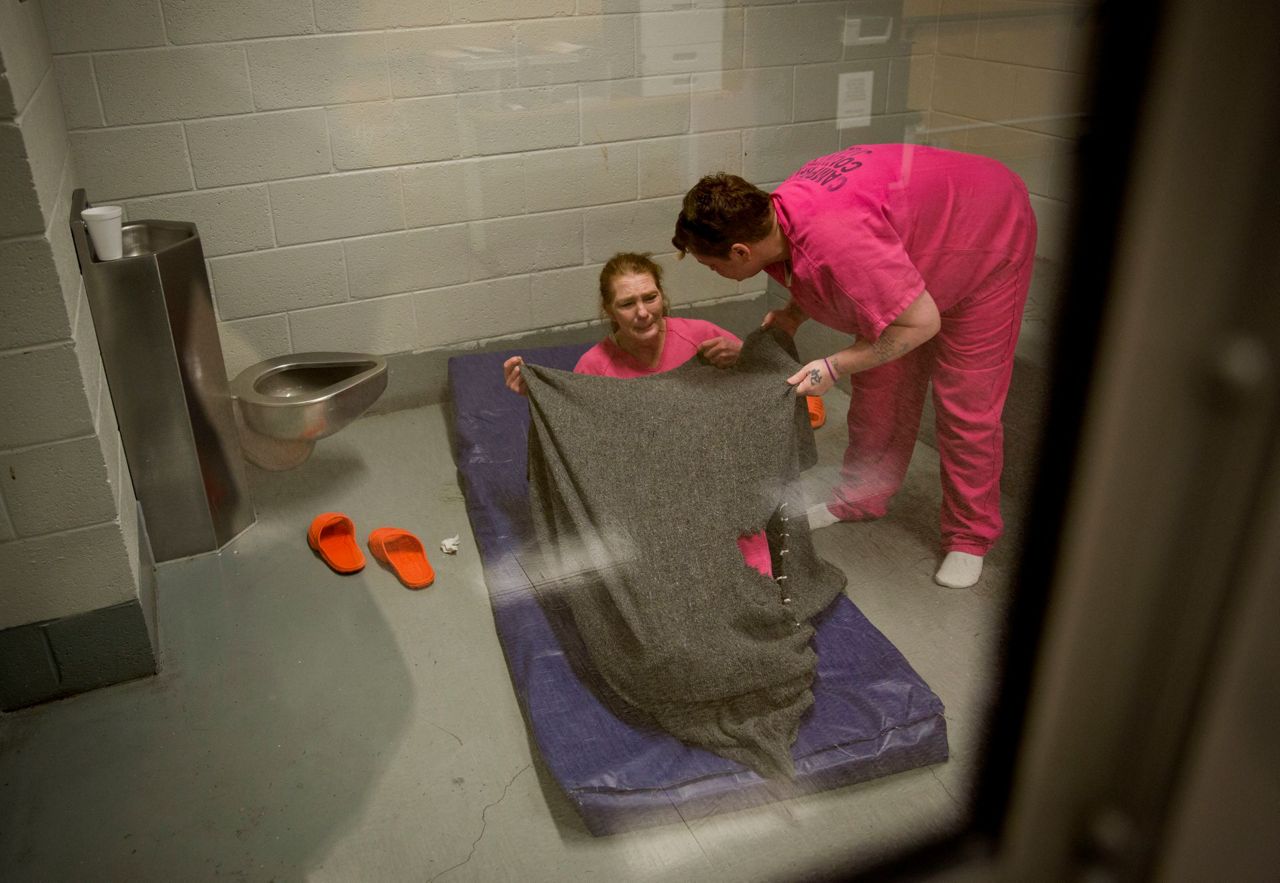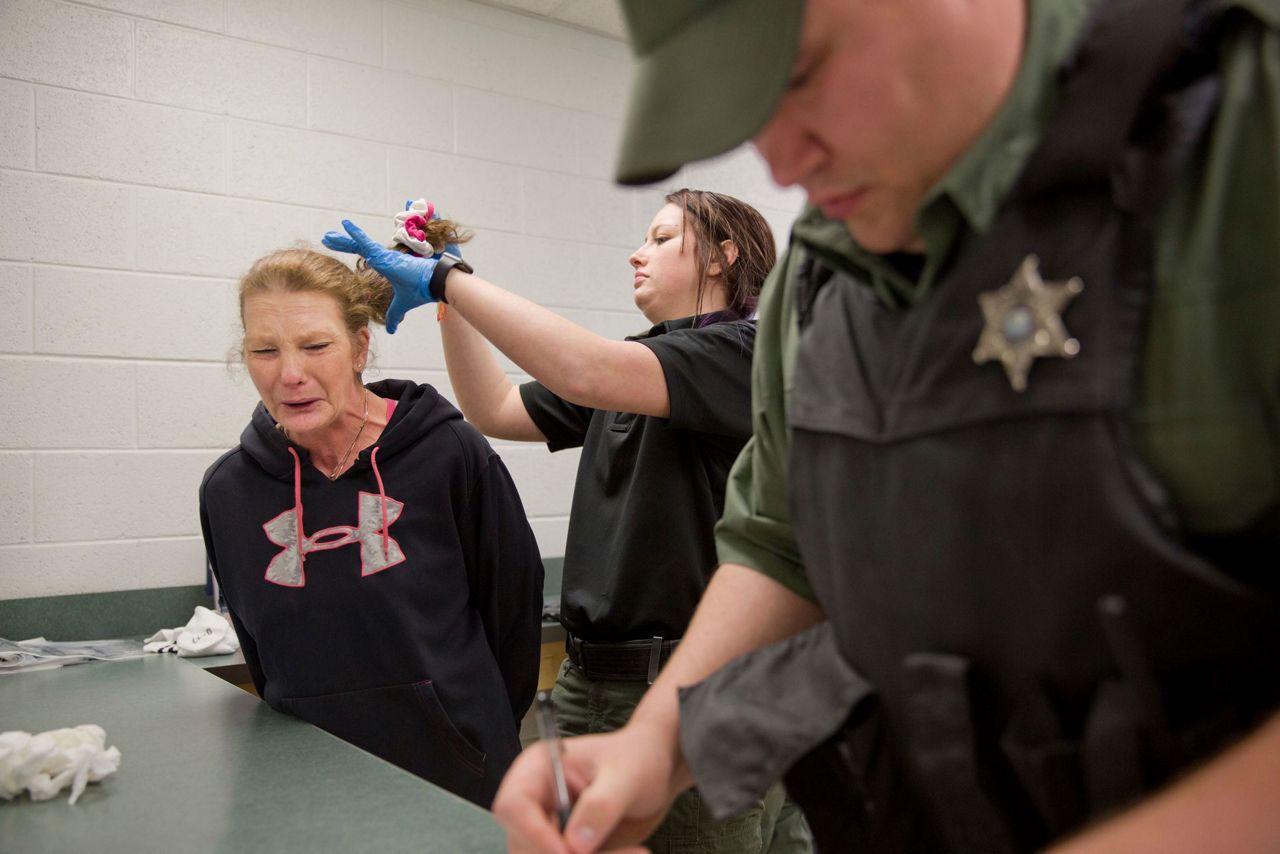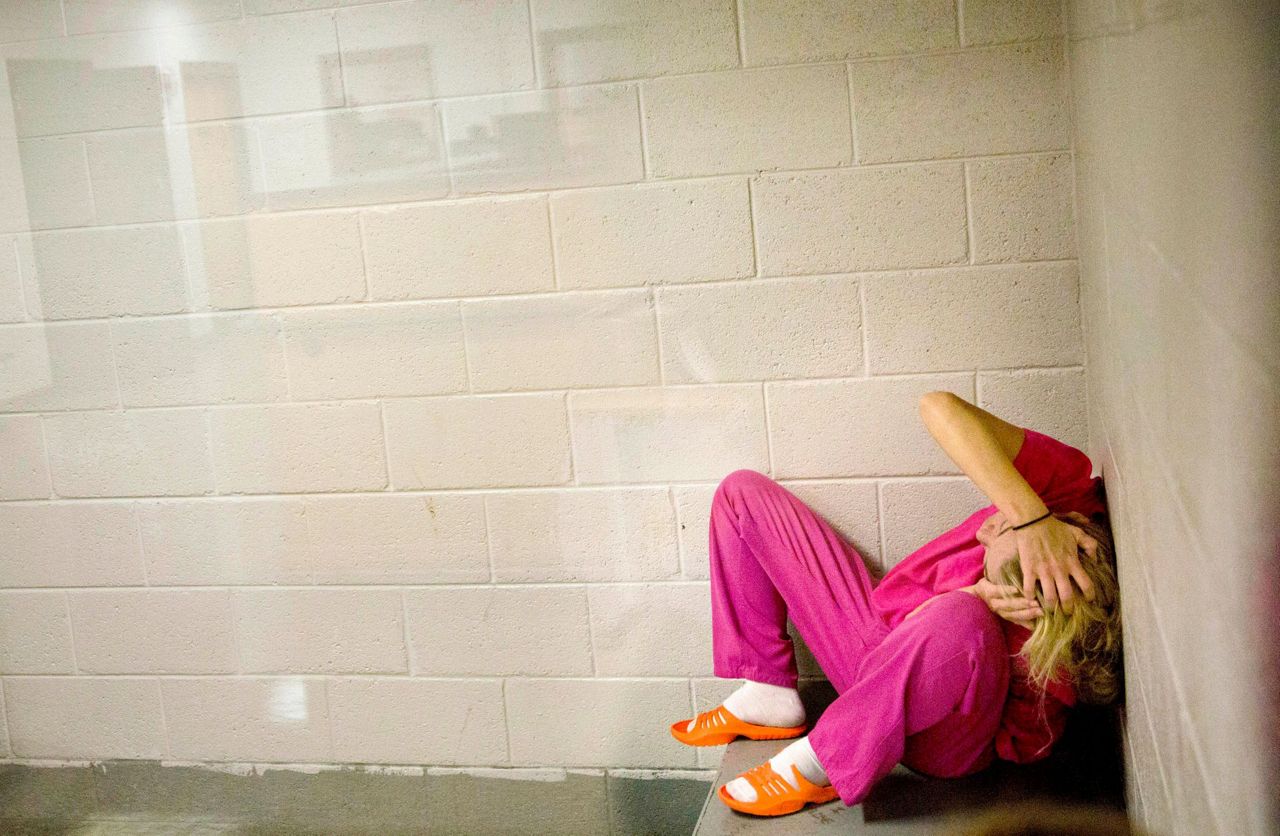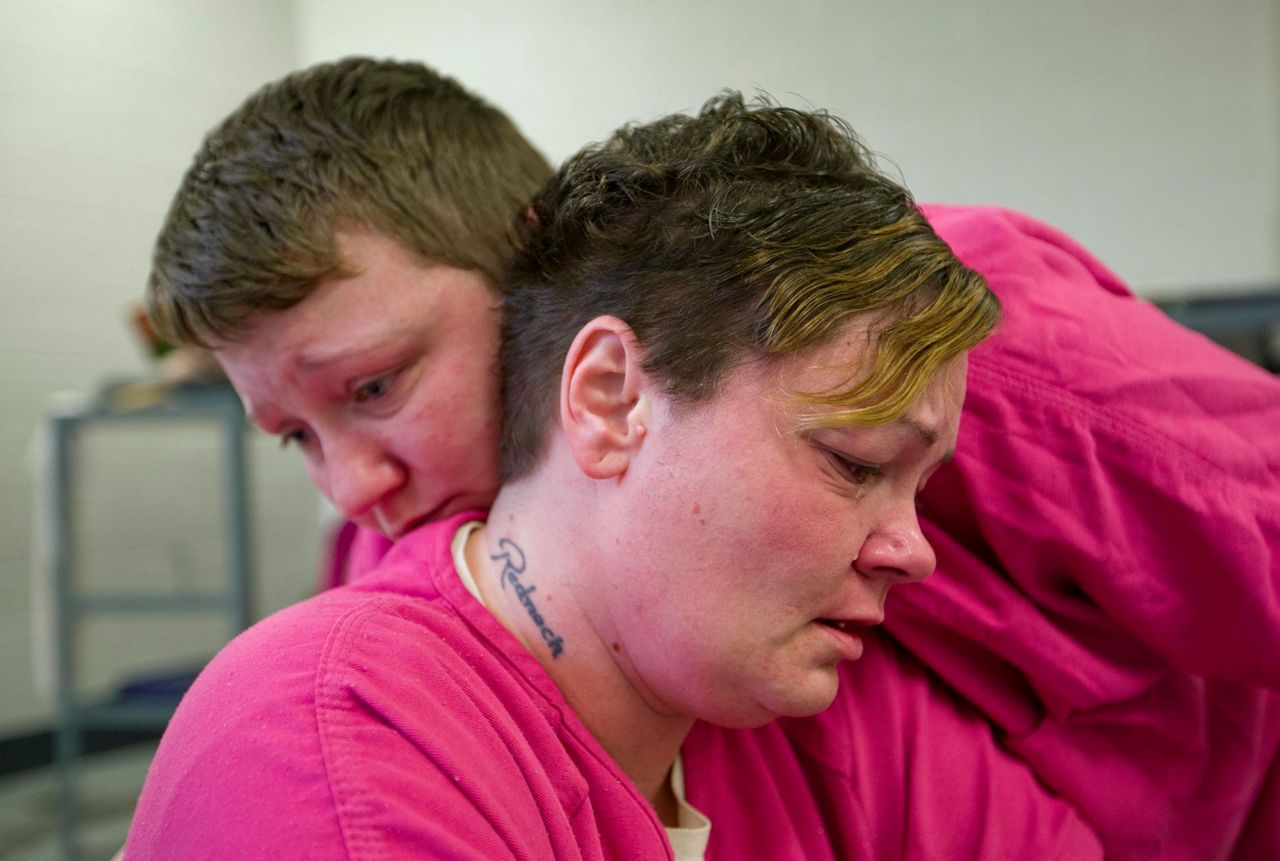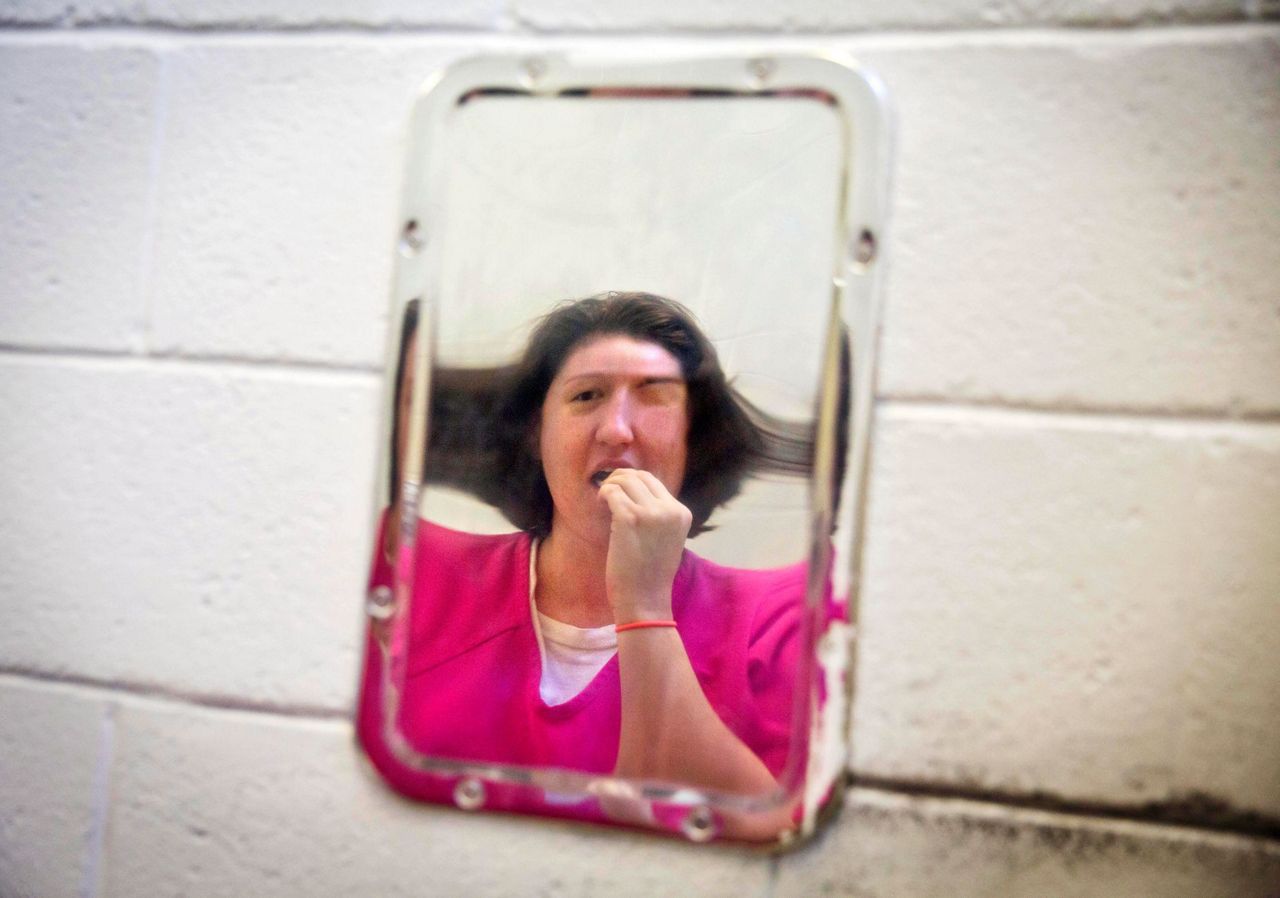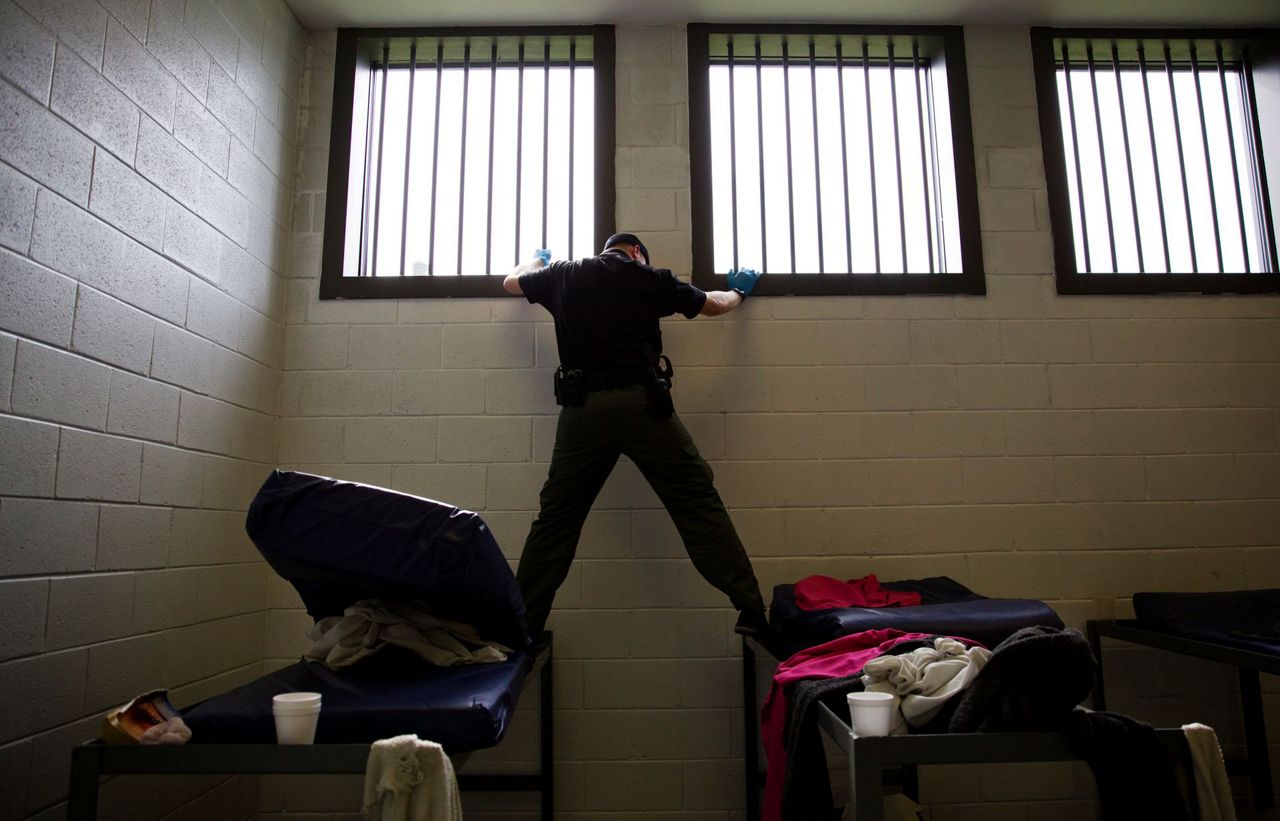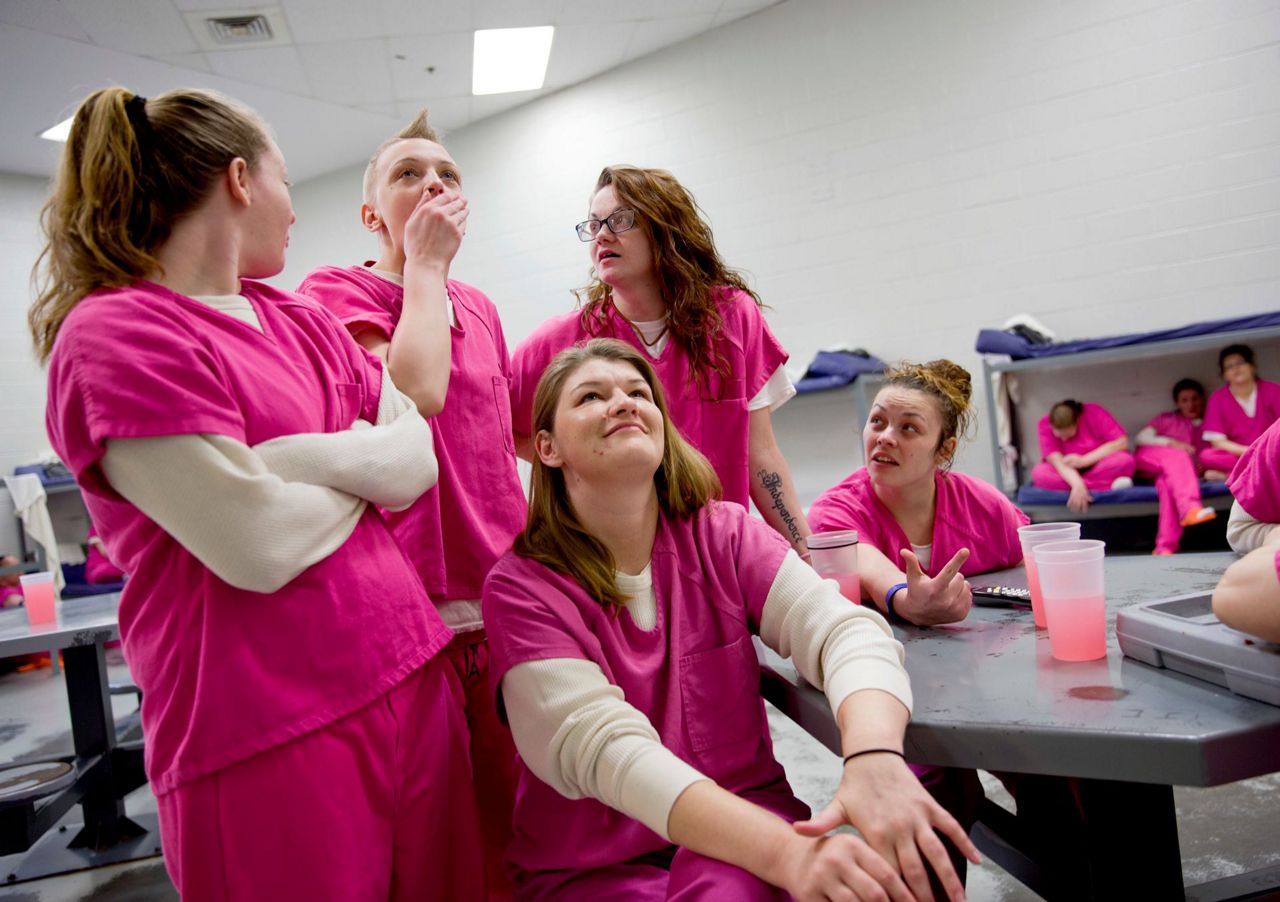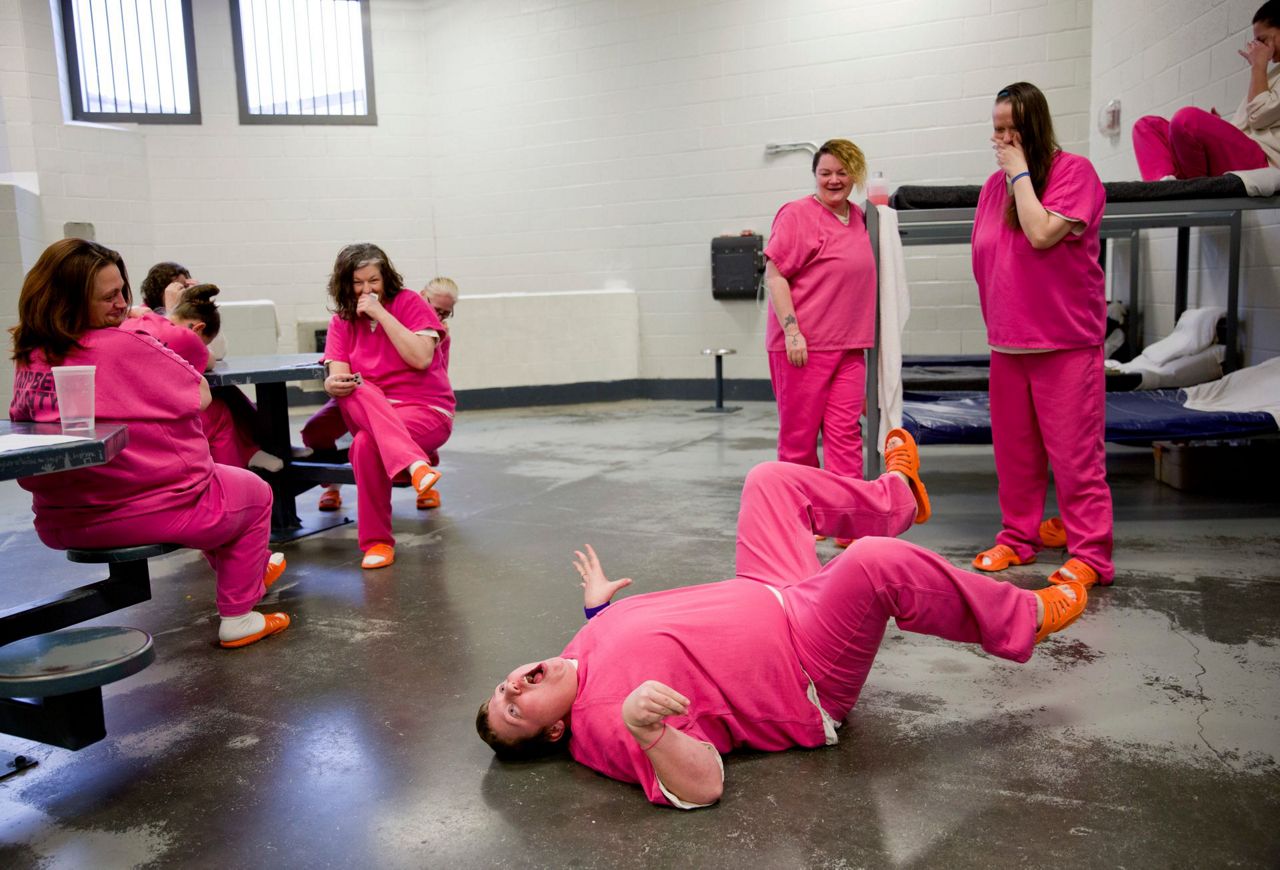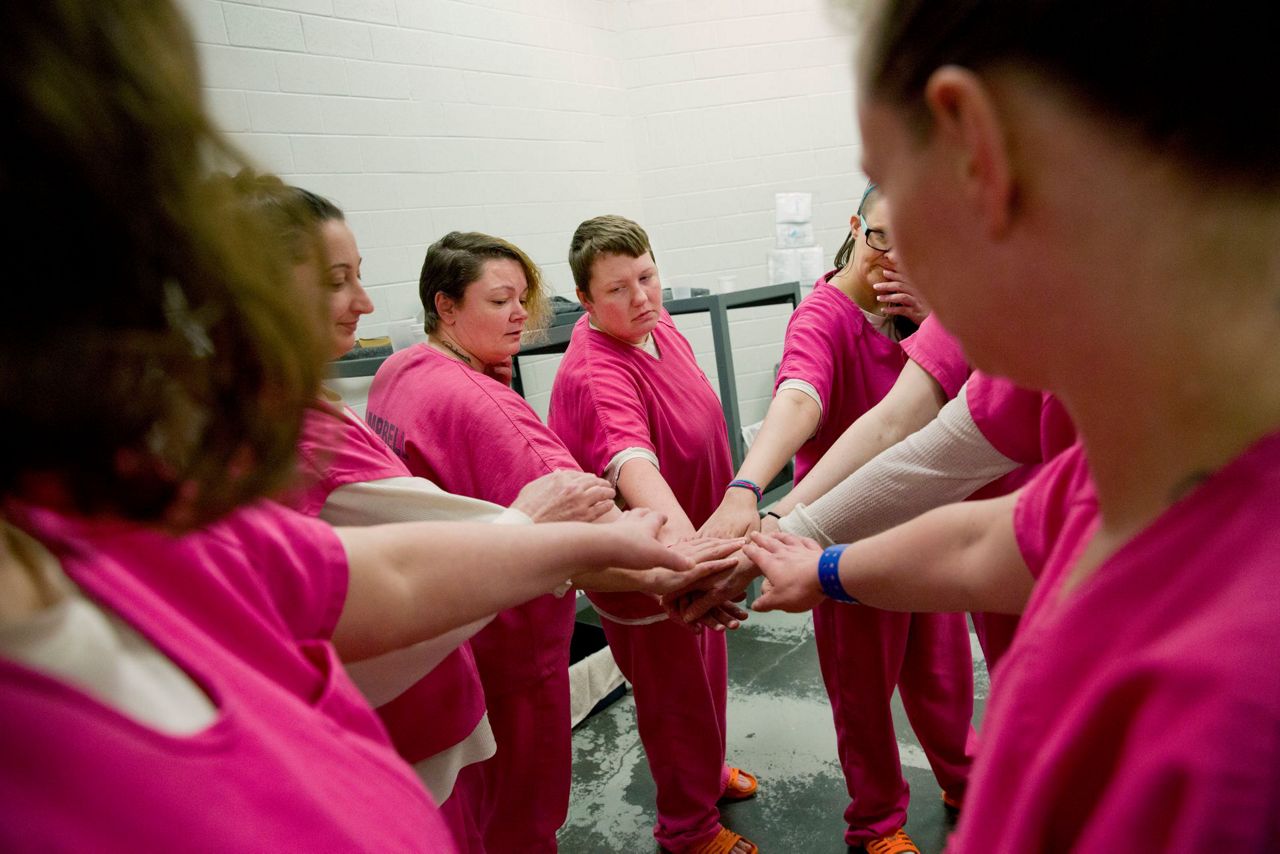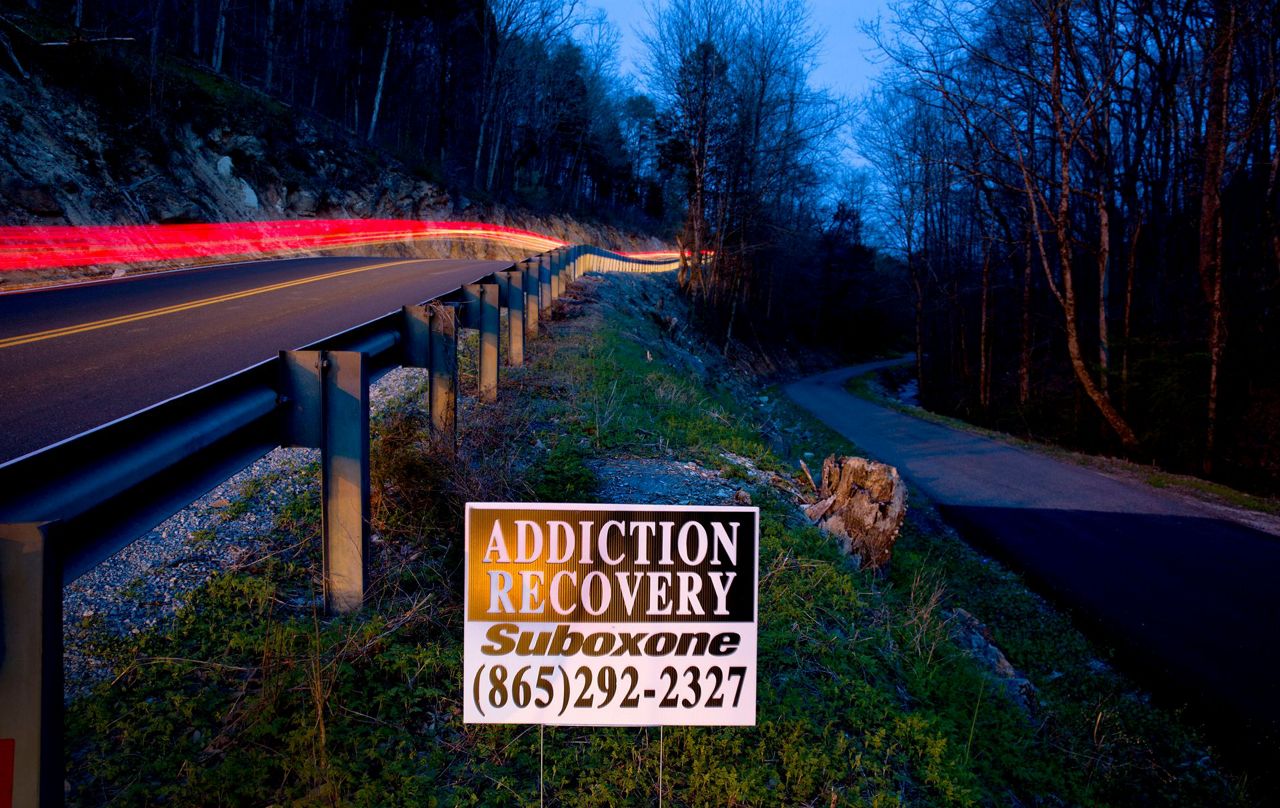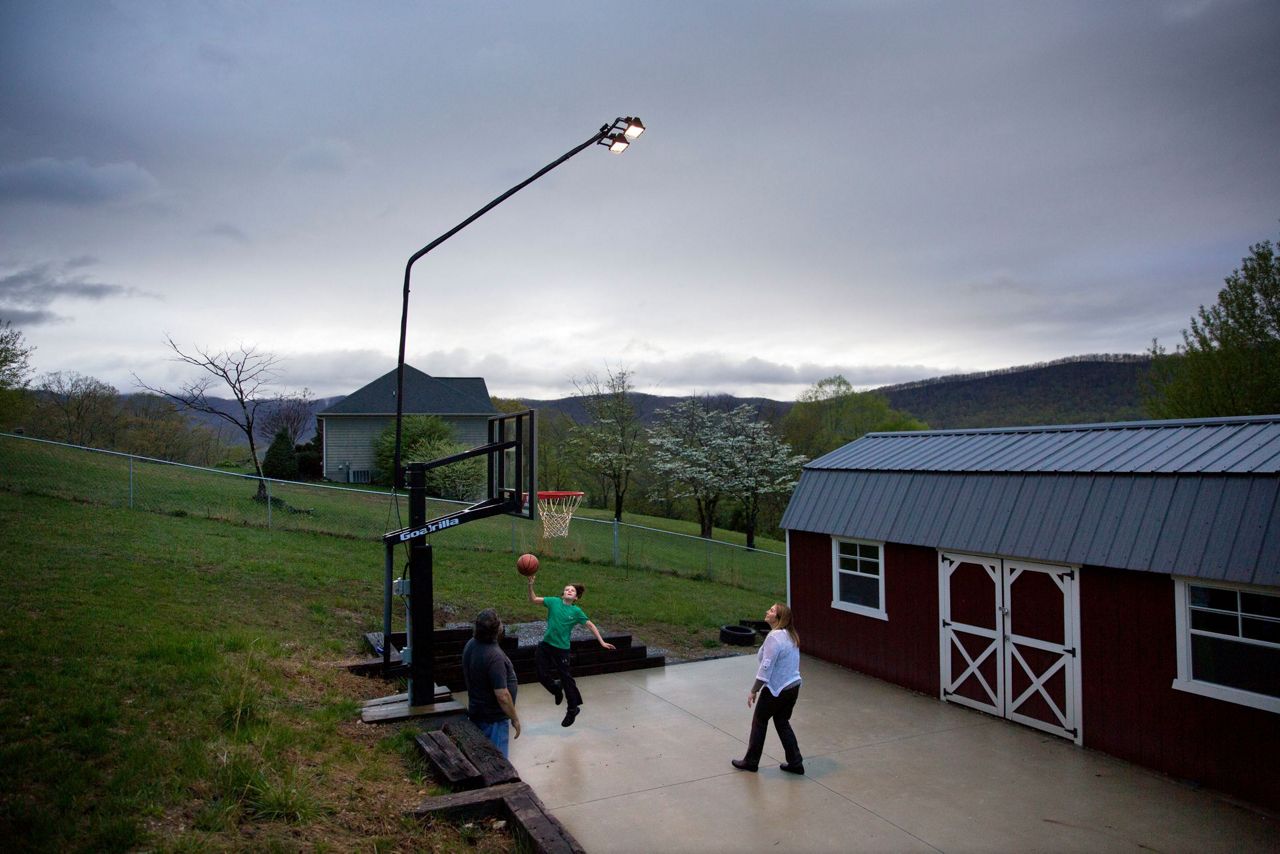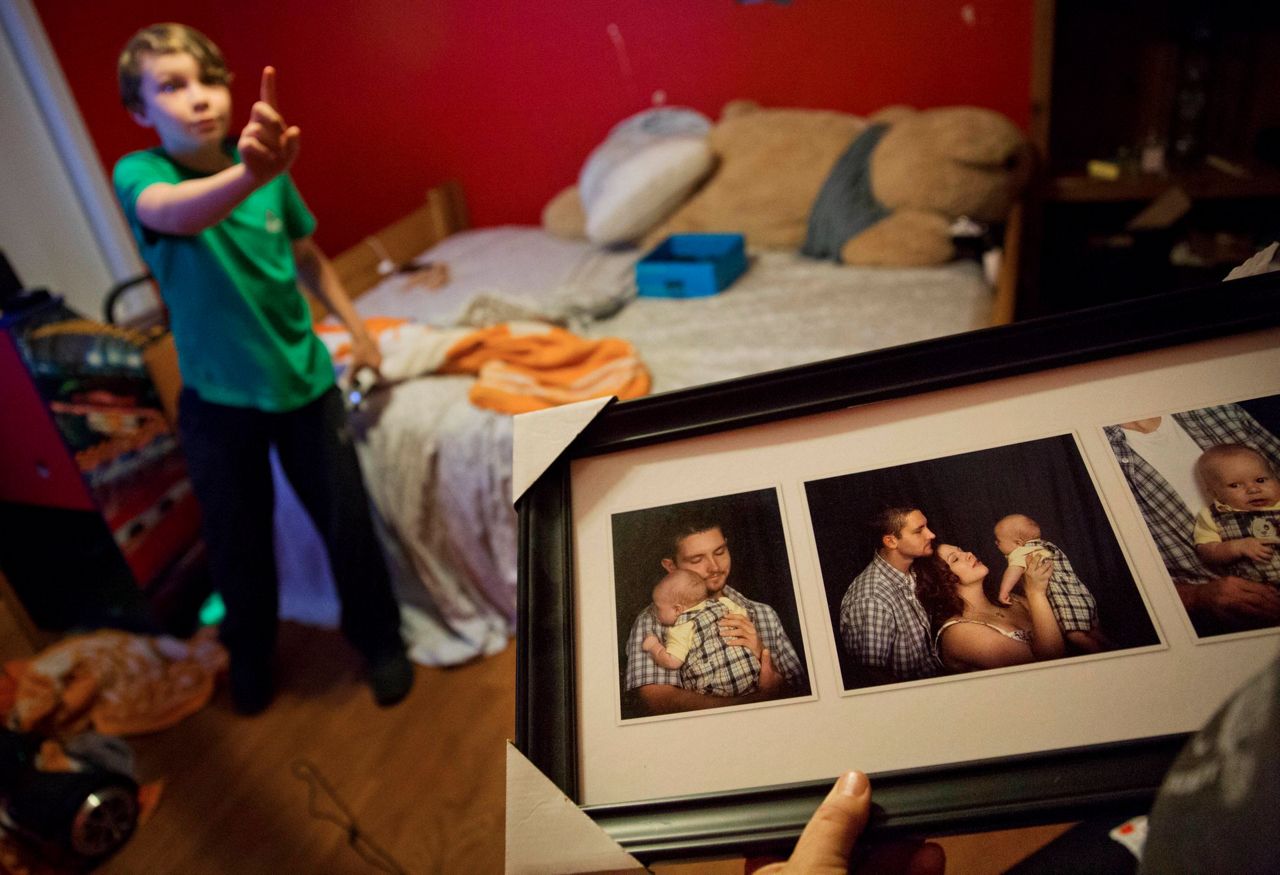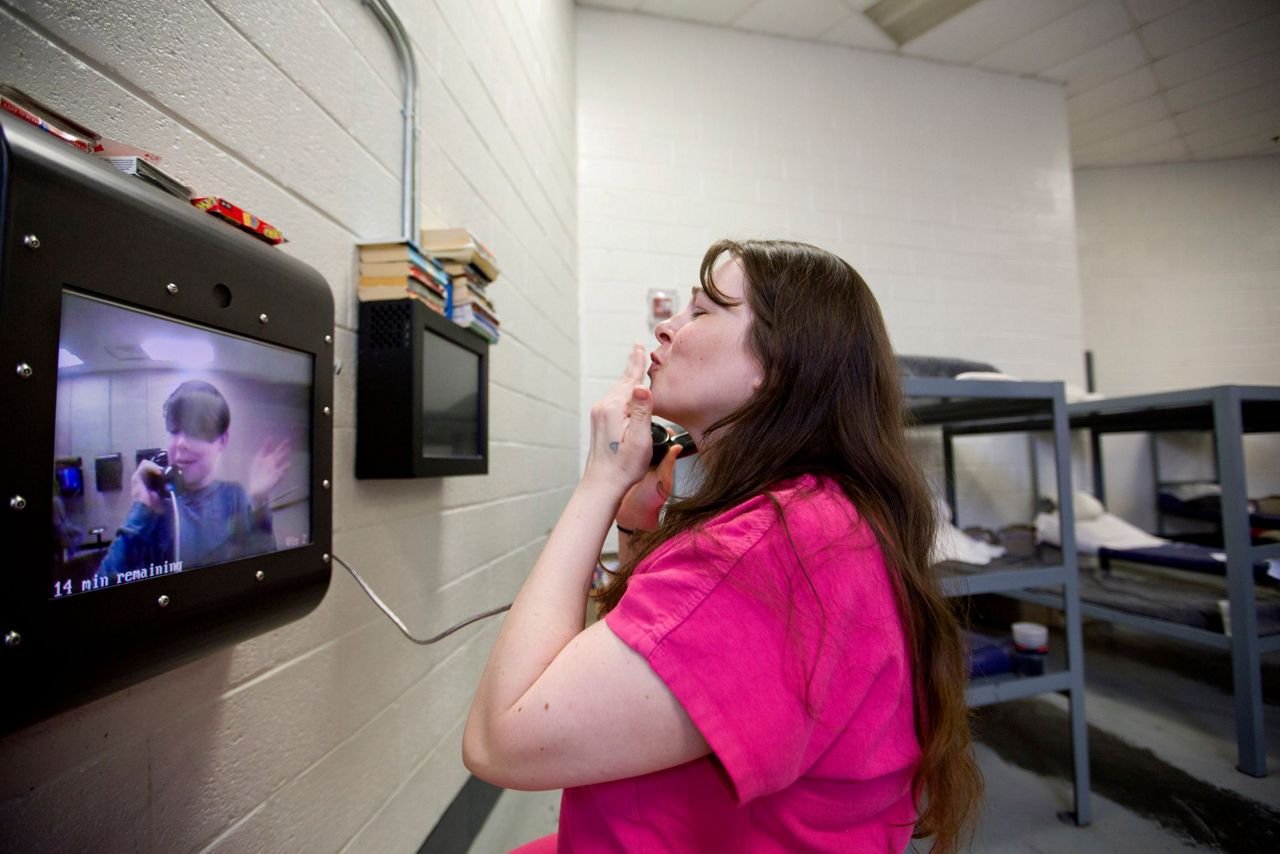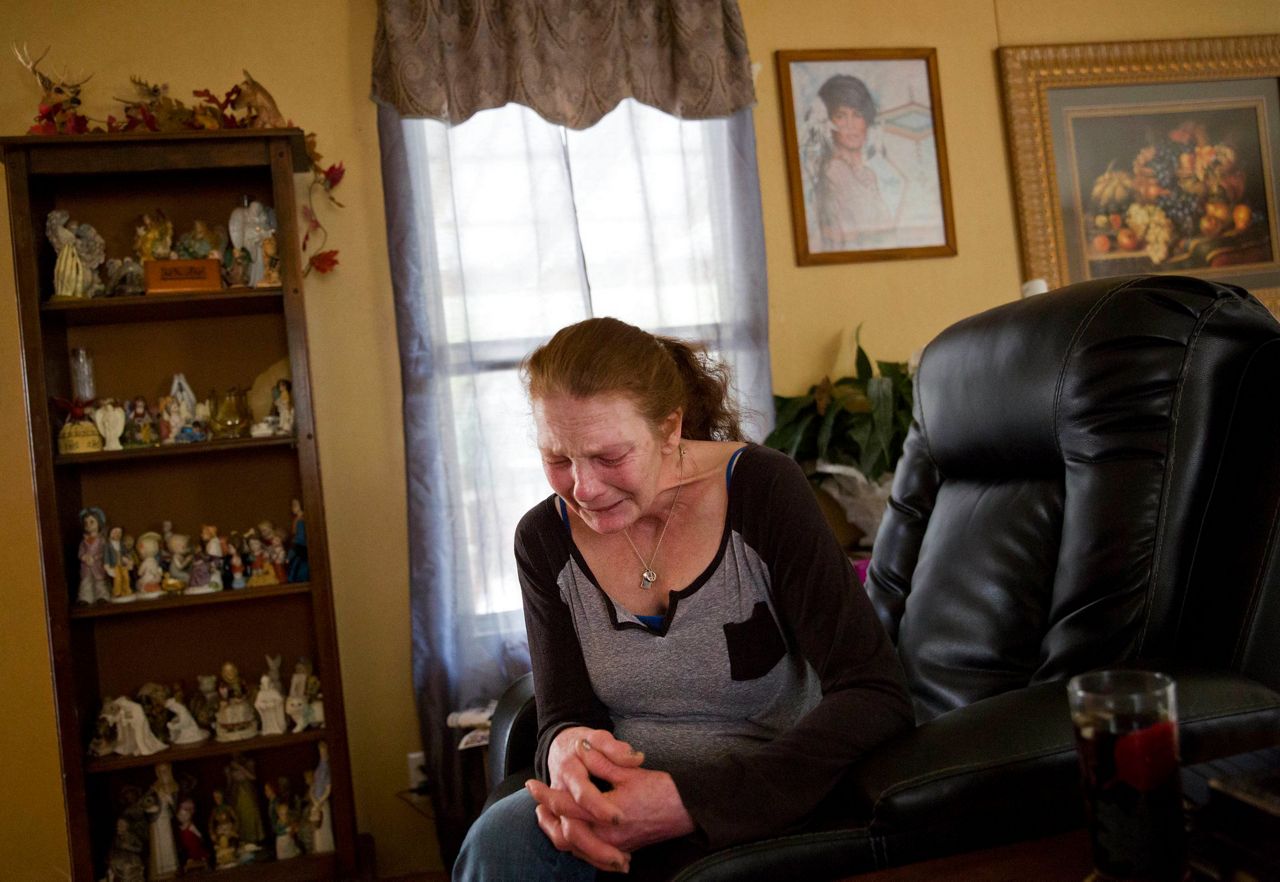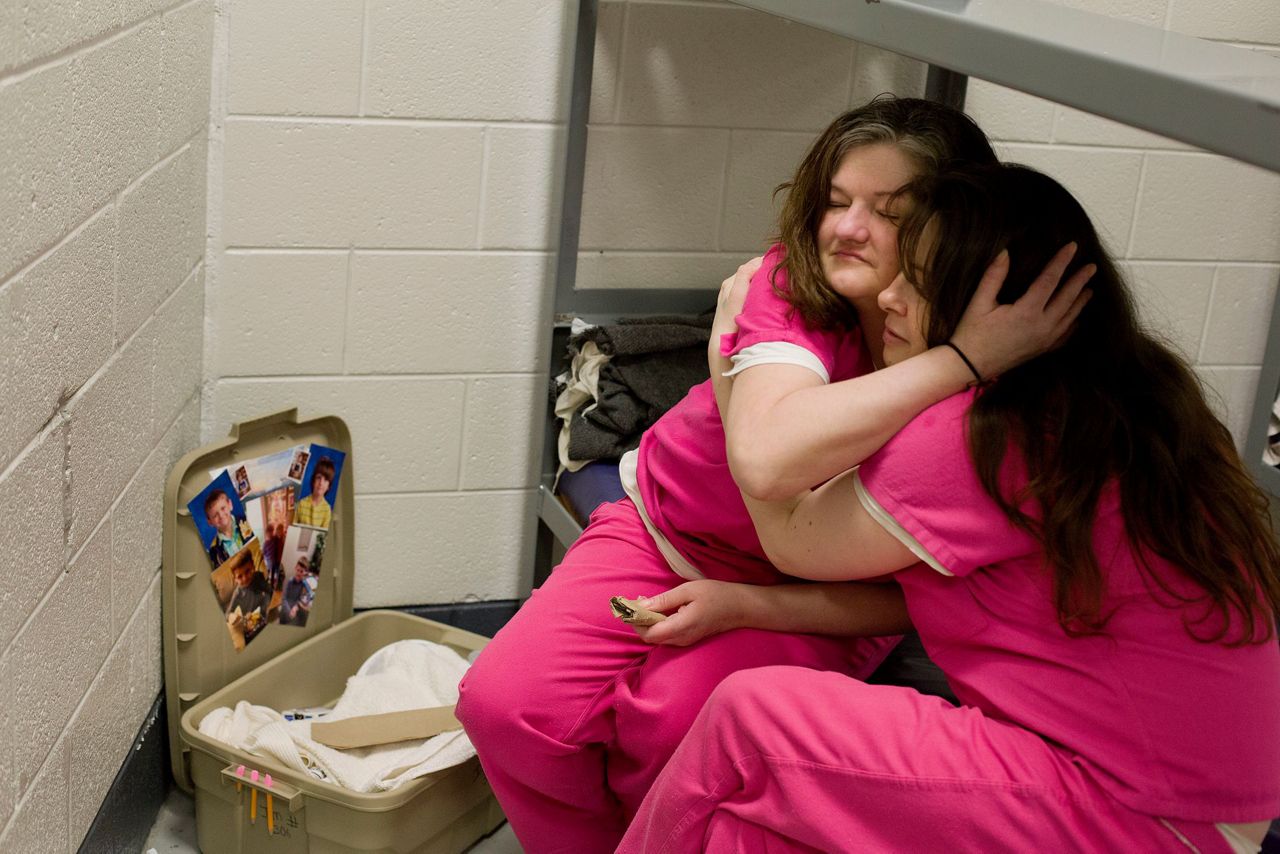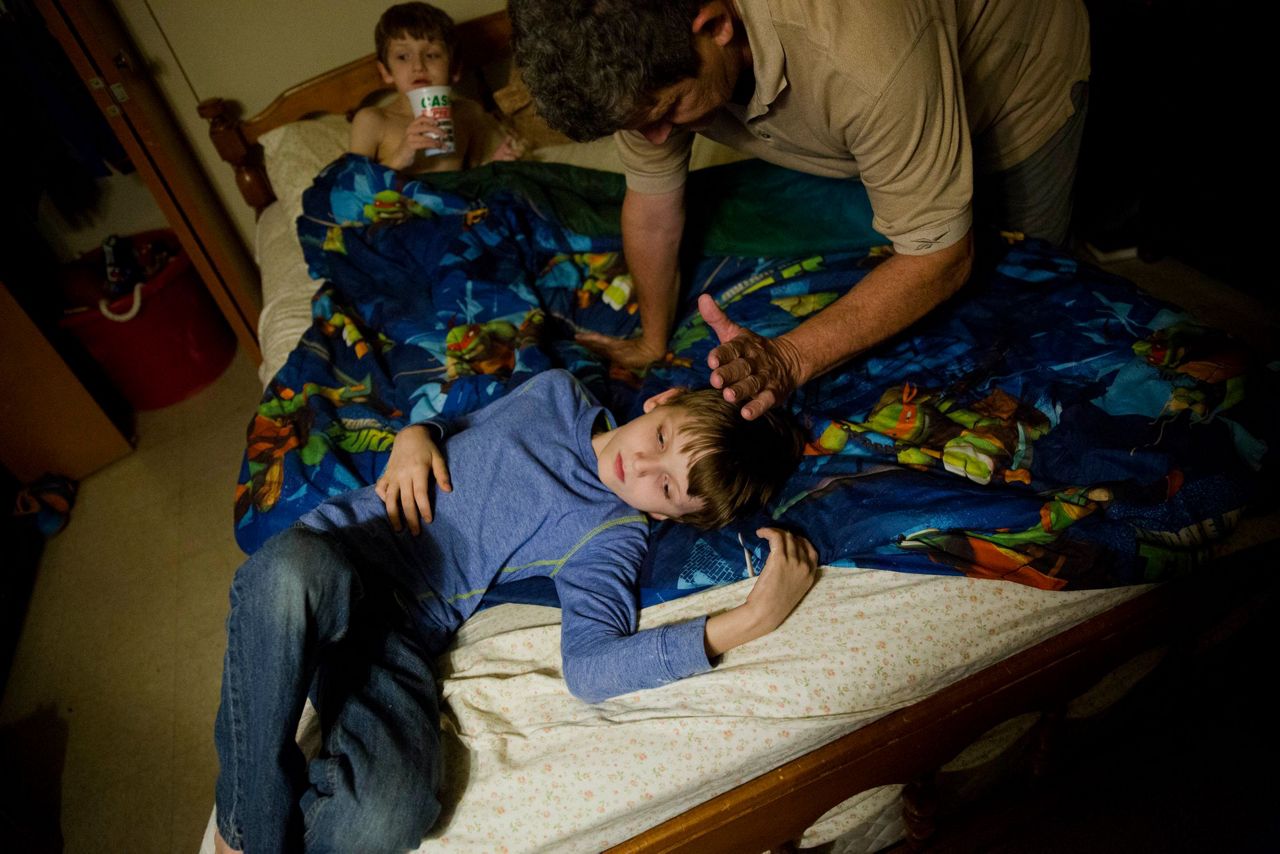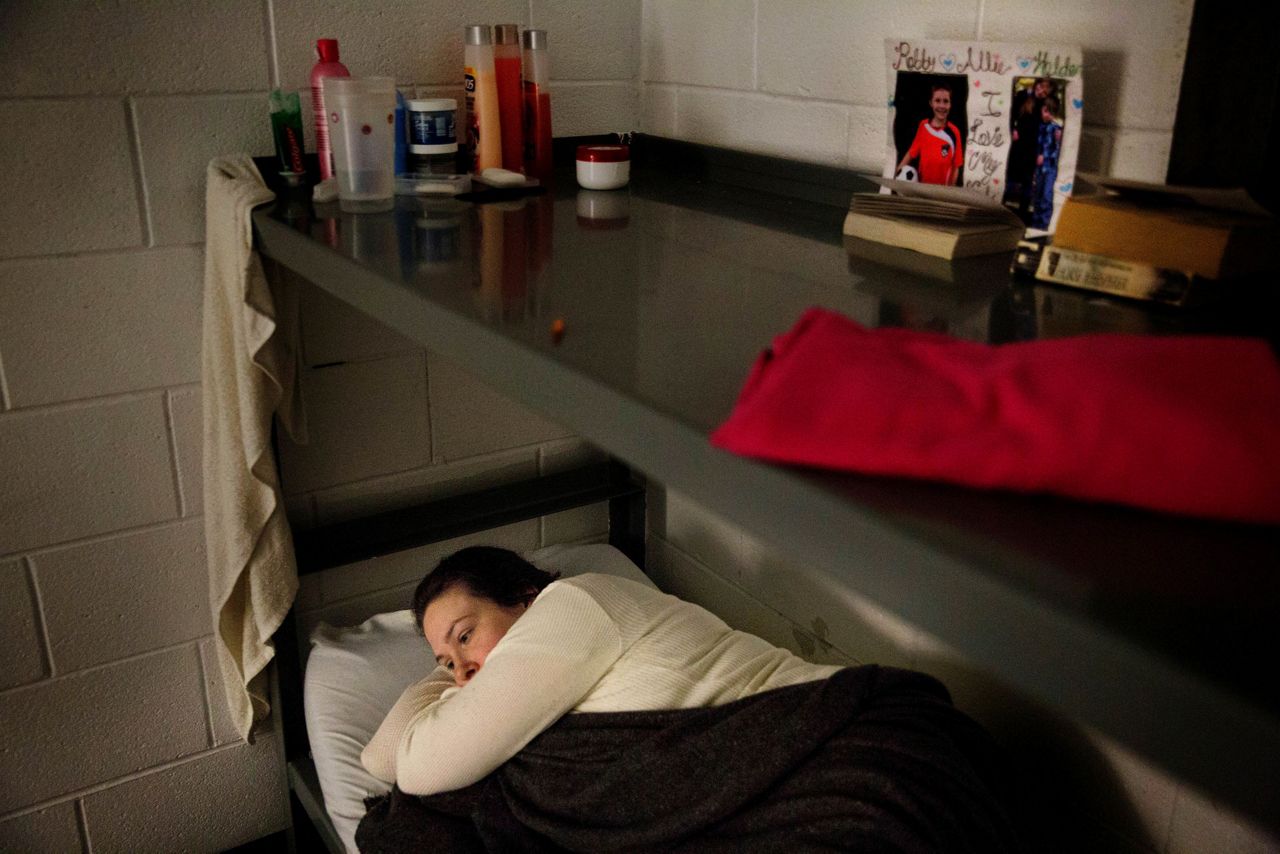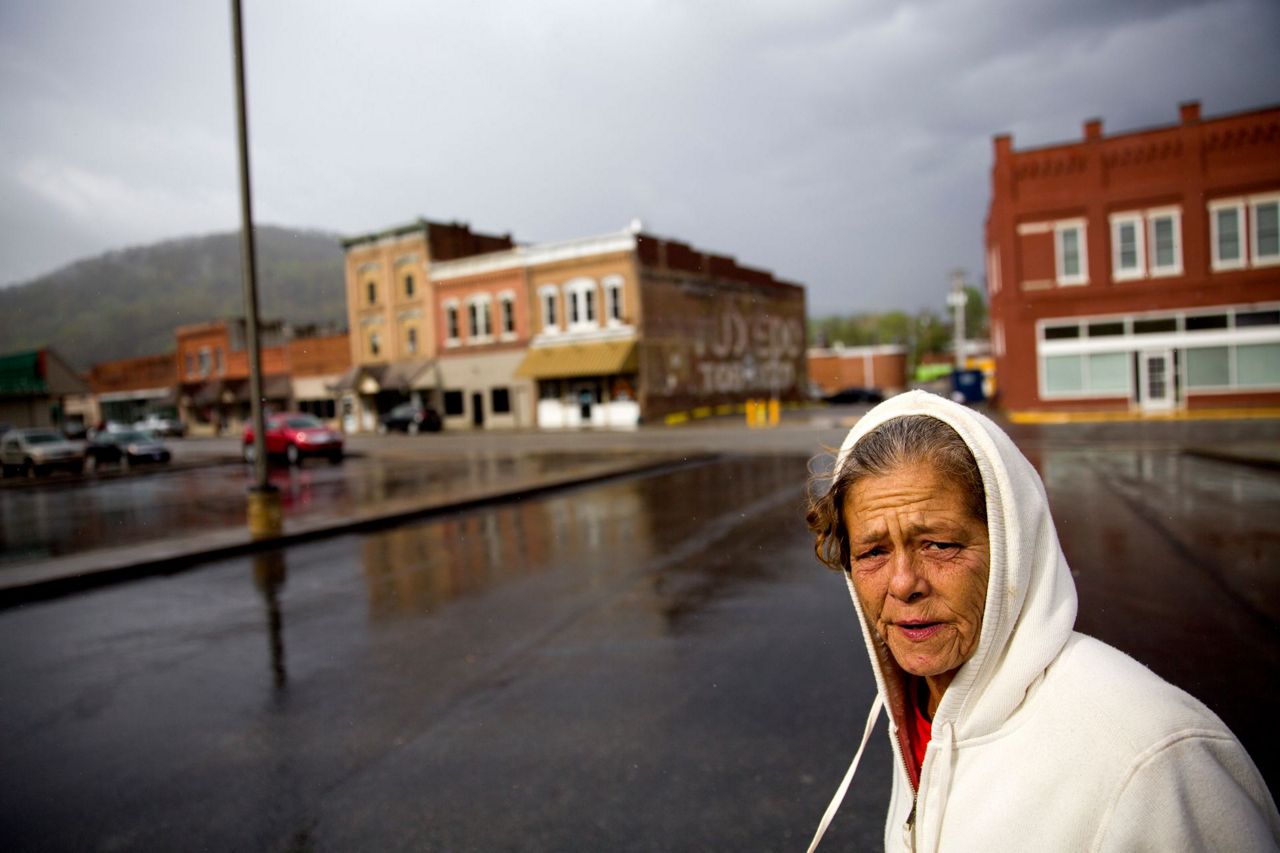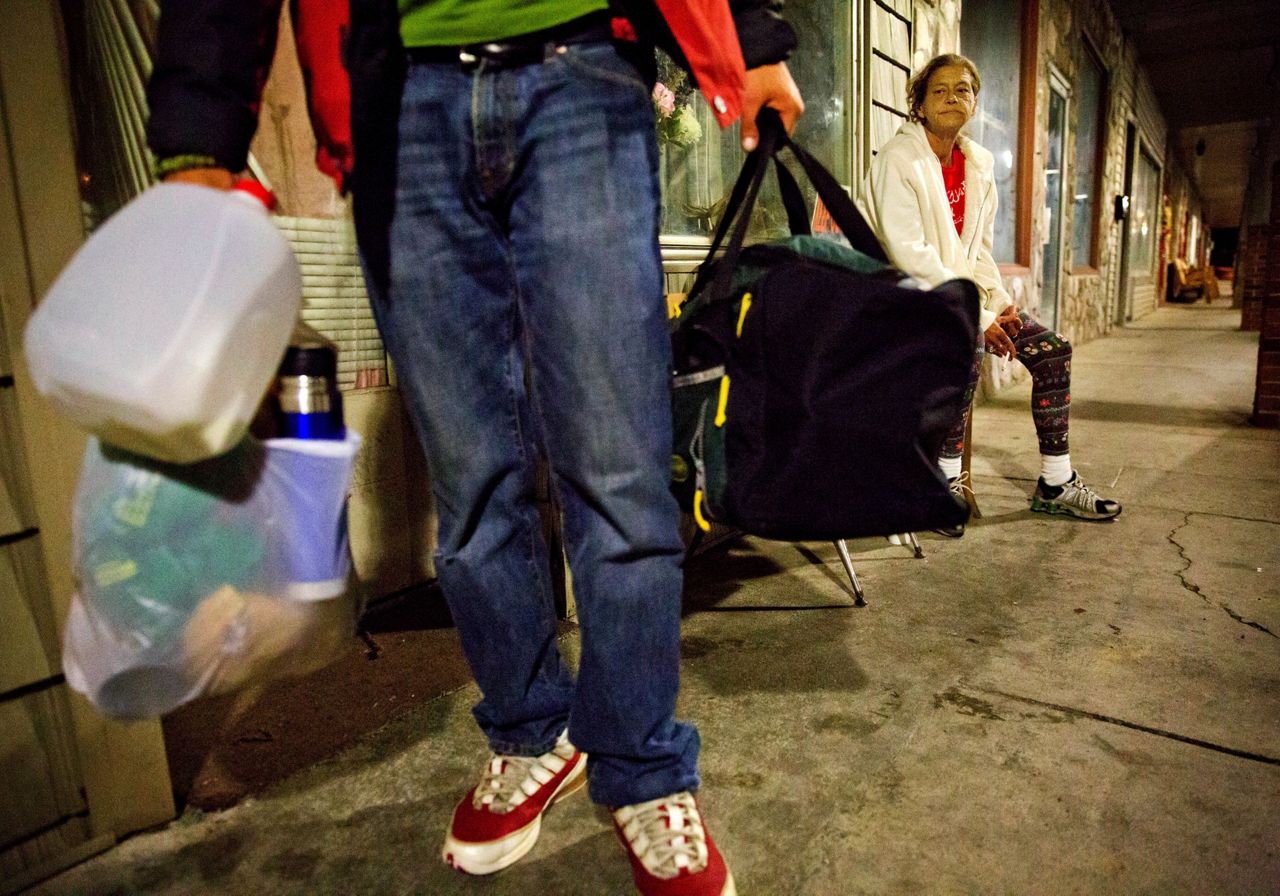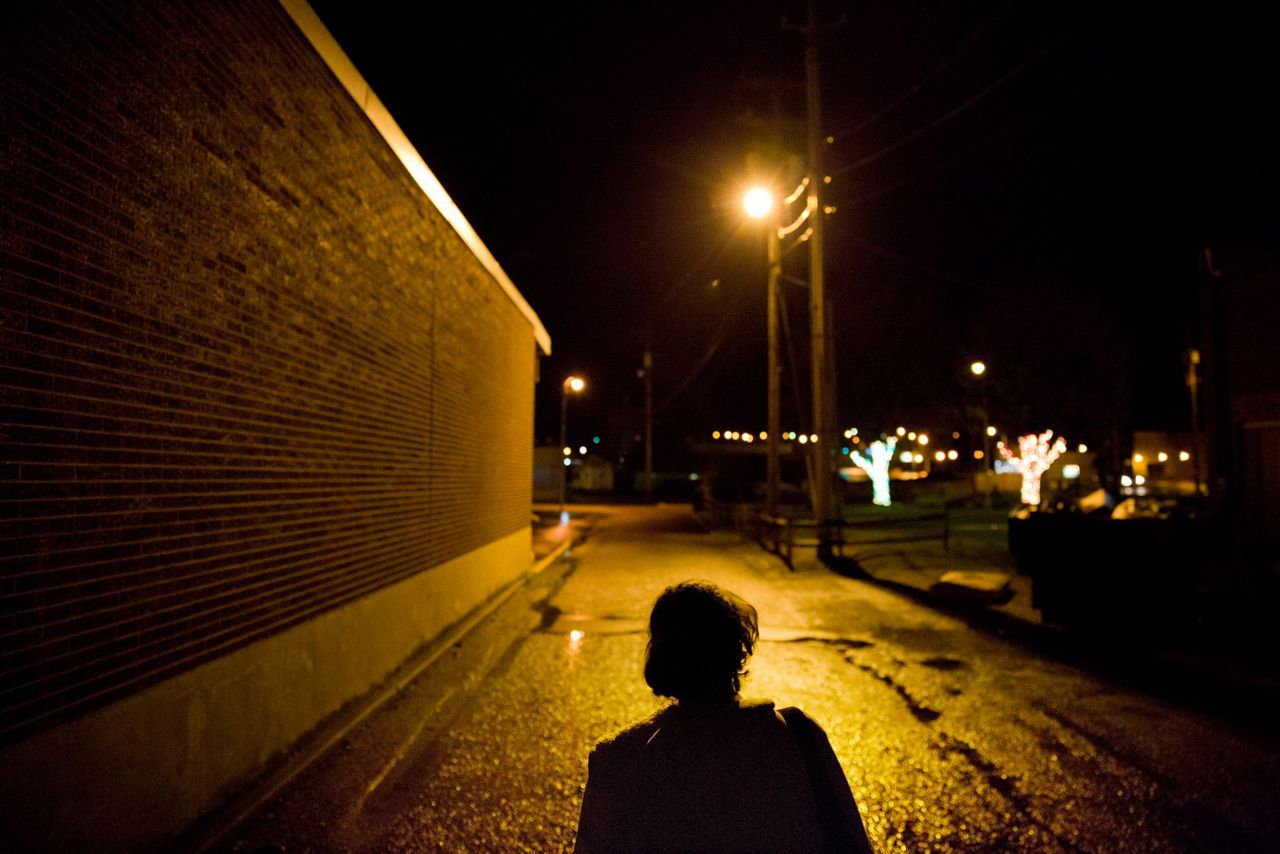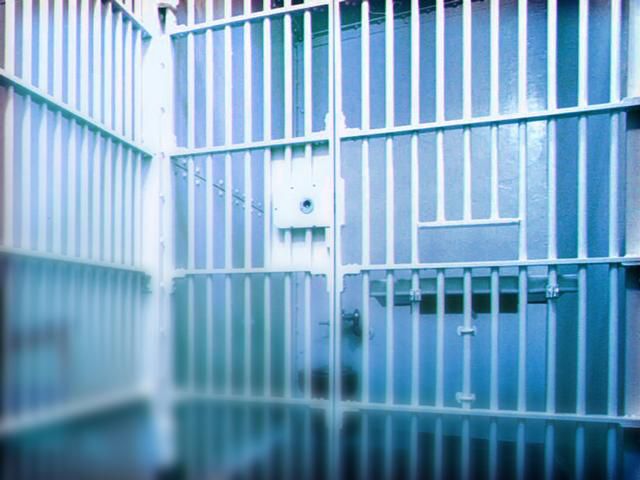JACKSBORO, Tenn. (AP) — On opposite sides of the county jail, a mother and her son chat about school, girls, birthday gifts — and their future together. They aren't allowed to see each other face-to-face, so the inmate and the fifth-grader connect by video.
"Hi, Mommy," 10-year-old Robby says to Krystle Sweat, clutching a phone in the visiting room as he looks at his mother on a screen, sitting in her cell.
Robby hasn't hugged or even touched her since Christmas Day 2015, just before Sweat wound up back behind bars. He runs a hand through his hair, shifts his weight from one leg to another, and says that on the day his mom is released, he wants to show her how he can ride no-hands on his bike. Sweat laughs, but knows their reunion must wait.
For years now, she has cycled in and out of jail, arrested more than two dozen times for robbery, driving violations and other crimes — almost all related to her drug addiction that culminated in a $300-a-day pain pill habit. She's tried to quit, but nothing has worked. Now she says she's ready to make the break when she's paroled again, possibly this summer.
"I'm almost 33," she says. "I don't want to continue living like this. I want to be someone my family can count on."
This lone county jail in a remote corner of Appalachia offers an agonizing glimpse into how the tidal wave of opioids and methamphetamines has ravaged America. Here and in countless other places, addiction is driving skyrocketing rates of incarcerated women, tearing apart families while squeezing communities that lack money, treatment programs and permanent solutions to close the revolving door.
More than a decade ago, there were rarely more than 10 women in the Campbell County Jail. Now the population is routinely around 60.
Most who end up here have followed a similar path to Sweat: They're arrested on a drug-related charge and confined to a cell 23 hours a day. Many of their bunkmates also are addicts. They receive no counseling. Then weeks, months or years later, they're released into the same community where friends — and in some cases, family — are using drugs. Soon they are again, too.
And the cycle begins anew: Another arrest, another booking photo, another pink uniform and off to a cell to simmer in regret and despair.
Sarai Keelean has been jailed about eight times in six years. One Christmas, her mother joined her. Like Keelean, she is addicted, and had been arrested on a driving offense. Mother and daughter spent the holiday crying in each other's arms.
Keelean is back in for violating probation for possessing meth; she'd been using the drug and also selling it to buy opioids. Locked up now for almost three years, she longs for freedom but is terrified, too. "You're afraid that you're going to mess up," she says. "Nobody wants to come back here."
Blanche Ball, who has used, cooked or sold meth for 15 of her 30 years, has been in jail several times, mostly for short periods until now. She thinks about her four children constantly and recently dreamed her 3-year-old son was a doll broken into pieces.
"I know I could have done something more with my life," she says, but: "Once you're like this for so long, you don't know another way to be."
___
In America's ongoing battle against addiction, Campbell County faces formidable odds. In 2015, it had the third-highest amount of opioids prescribed per person of all U.S. counties. The numbers identified by the Centers for Disease Control and Prevention were more than five times the national average — or enough opioids to medicate every single resident here around-the-clock for 15 weeks.
Mayor E.L. Morton blames the pharmaceutical industry and doctors, and two lawsuits against opioid makers are pending on behalf of the county and its 40,000 residents. "If you were fighting the Mafia, you'd be aiming for the head of the organization," he says. "Well, the top of this organization is fully legal, and we have the most respected profession that is doing it to us."
Pills, though, aren't the only problem. With 500 square miles of mountains, thick woods, winding back roads and deep hollows, this county on the Kentucky border has been a prime spot, too, for meth. While homegrown labs are on the wane, a powerful strain of the drug from Mexico has found its way here.
"Throw a rock, hit a house, and there's drugs," says Keelean, the 35-year-old inmate who says she didn't have a major problem until she moved back about five years ago. "I just got sucked into a vortex of destruction and drug use."
The county has been struggling for decades. Its once-thriving tobacco farms and coal industry disappeared long ago, taking with them a vital cash crop and jobs that supported a middle-class life. Some factories remain, but more than 1 in 5 residents are poor.
Nowadays, as much as 90 percent of the crime in a five-county district that includes Campbell is connected to drugs, the local prosecutor says. Women are often the culprits, and communities across the nation are seeing similar patterns.
Women in jail are the fastest-growing correctional population in America. Their numbers rose from 13,258 in 1980 to 102,300 in 2016, with the biggest jump in smaller counties, according to the Bureau of Justice Statistics. Similarly, the female prison population skyrocketed from 5,600 in 1970 to more than 110,000 in 2016. Between 1980 and 2009, the arrest rate for drug possession or use tripled for women, while it doubled for men.
Opioid abuse has exacerbated the problem.
In Montgomery County, Ohio, more than 3,600 women have been jailed for addiction-related crimes in the last two years, twice the number since 2014. In Henrico County, Virginia, the female jail population has grown from about 60 daily in 2000 to nearly 300; a survey of inmates found more than 4 in 10 women had their kids removed from them while on drugs. The jail has responded with an opiate treatment program.
Rural America, in particular, lacks resources and readily accessible treatment to help curb the problem, says Jessica Hulsey Nickel, president of the Addiction Policy Forum, a patient advocacy group. If someone in recovery has to drive several hours to visit a specialist or receive regular doses of methadone, she says, "It's going to make staying on that path nearly impossible."
Mary-Linden Salter, director of the Tennessee Association of Alcohol, Drug & Other Addiction Services, says her state doesn't have enough psychiatrists, social workers, counselors and nurses in rural areas. Residential drug treatment, a key part of recovery, also is scarce in those communities — and Campbell County has none, she says, adding: "It's unrealistic for people to travel 700 miles for treatment because that's where there's an open bed."
Salter also notes there are twice as many residential programs in the state for men as there are for women. That's partly because women have costlier, more complicated treatment; many have experienced trauma and abuse as children or adults. Generally, women also are slower to seek help because of societal pressures to maintain a family. Many are single mothers who fear losing their children.
"Women are the caregivers of their families," Salter says. "They get blamed and shamed for not taking care of their children. But they get blamed and shamed for not being in recovery. It's a horrible choice."
___
A view from the glass-enclosed guard tower that peers into the women's unit at the Campbell County Jail: Metal beds flank the walls. Giant bars seal the windows. In dormitory-like cells, the women watch TV, play endless games of cards or pace in silent frustration, counting the days until their release.
They sleep, shower and eat in the same room. On their one hour outside the cell, they can visit an exercise room, but it has no equipment so the women improvise, rolling toilet paper into balls they swat around, using their plastic sandals as makeshift tennis rackets.
Each woman has a story of bad choices, dreams of a "normal" life and nagging doubts about how long they can resist drugs on the outside.
Their voices are weary. They comfort each other, embracing when a parole bid is denied or when the unthinkable happens — an inmate's son is killed and she sobs, grief-stricken and angry because she's not permitted to attend his funeral.
Sarai Keelean says drugs made her feel "like supermom," then numbed her during her divorce. Her ex-husband is raising their boys, whom she hasn't seen in five years. If she could talk to her 11- and 13-year-old sons, she'd tell them: "I love you, and I'm sorry, so sorry."
"I kick myself in the butt because I chose drugs over them ... the most important, wonderful things in my life."
Keelean's younger sister is an addict, too — in treatment now. Her mother visits every Saturday, but she's fighting her own addiction to suboxone, which was supposed to wean her off the opioids she started taking for arthritis.
Keelean says she'd like to be a productive citizen and thinks she might be a good drug counselor, but she recently woke at 3 a.m., panicked she won't know how to navigate freedom. "I just feel socially awkward to go out there and be normal and do right."
Many of these women say jail should help prepare them for life outside, maybe with a Narcotics Anonymous group, counseling or education programs such as those offered in state prisons. They'd also like to work and be exposed to people who don't use drugs. (Some male inmates have jobs.)
Lt. Mallory Campbell, assistant jail administrator, is sympathetic. It took a year, she says, to start a high school equivalency diploma program, partly because a teacher had to be found who then had to be trained to work in the jail.
She'd like to offer college courses or vocational training, she says, because "if they don't leave here with a skill, they're going to go back to what they know." But there isn't money for programs or staff.
Medical costs for both male and female inmates also are an enormous burden, nearly doubling since 2015 to top $1 million last year, according to county officials. Hepatitis, infections or dental problems are not unusual.
And drugs remain a powerful lure. The women speak candidly about what they had to do to feed their habits — shoplift, rob, trade sex for drugs. While some welcome the fresh start, the cravings persist.
"I think about drugs all the time," Blanche Ball admits frankly. "I call it relapsing. I relapse on a daily basis."
Ball says she grew up around relatives and others who regularly used drugs and, as a teen, learned to cook meth in her backyard and basement. "I thought we were having fun," she says. Ball recently shared a cell with another drug offender — her childhood babysitter.
By age 17, Ball realized she was on a disastrous course but couldn't stop. Since then, she's snorted, smoked, injected and ingested methadone, heroin, meth and various opioids. Like other inmates, her drug of choice is the painkiller Opana. A single pill can go for $120 on the street.
"My mother actually said to me once, 'You're never going to quit. You're just hardwired for it.' I thought, 'You're right.'"
Her two oldest children live with family, and she doesn't want to see them until she's certain she won't disappear from their lives. Her two youngest, both born dependent on methadone, have been adopted. "That wound is so bad," she says, "I try to block it out all the time."
Ball is set to be released next year, and hopes she'll have the willpower to remain sober: "I'm not poor-spoken or slow. I have faith in God, first and foremost," she says. "I have faith in myself. It's just me wanting to get to the point where I get fed up."
Tennessee, which saw more than 1,600 drug overdose deaths in 2016 — a state record — is pouring more money into this problem. It's allocating about $14.5 million toward the opioid epidemic; more than half will go for treatment. In addition, the state is currently using a federal grant of more than $13 million, also mostly for treatment.
It's too early to know how much of that might funnel into Campbell County. For now, for those who do want to change, there are some places to seek help.
A drug court, which involves supervision for up to two years, has a 70 percent graduation rate. Participants often enter residential treatment, which also is available in a new program designed specifically for women. In both cases, treatment takes them to other counties or out of state.
The county also has a recovery house. The Harbor, a nondenominational church that runs the house, recently started sending volunteers to make weekly jail visits. When the women are freed, the church offers help with food, clothes and jobs. "We want to help them put the pieces of the puzzle back together," Pastor James Coffey says.
Monica Poston, case manager of the drug court and a recovering heroin addict, says it's generally best for those who complete treatment not to move back home, where temptations remain and opportunities are limited.
"We can't get them through rehab, pat them on the back, help them get their GED and their driver's license restored, watch them get a job and then ask them to live on minimum wage," she says. "You're setting them up to fail."
Phyllis Clingner agrees that relocating often offers the best chance for success. A former educator and foster care volunteer, she helped create the new Women In Need Diversion program that takes those jailed on misdemeanor drug charges before sentencing and moves them into short- or long-term residential treatment. The program has served about a dozen women so far.
"We try to build resilience," Clingner says. "Most of these women feel they're ... not worthy of a healthy lifestyle. We try to prove differently."
___
Krystle Sweat's drug problems have consumed almost half her life.
Her parents still struggle to understand how the girl who sang in the church choir, played guitar and piano, and dabbled in gymnastics and cheerleading ended up this way. Her troubles began when she started hanging out with the wrong crowd and dropped out of high school.
The Sweats have raised Krystle's son since he was about 3. Over the years, they've paid her rent, bought her cars, and invited her and her boyfriend to share their home. Sweat wound up stealing tools, a computer and camera — anything she could pawn.
"While she was here, it was total hell," says her father, Eddy. "When she went in jail I actually felt relieved. ... I knew I wasn't going to get that call at 1 o'clock in the morning saying that Krystle's died of a drug overdose, because I knew that was coming."
Sweat tried drug court once, but quit. "I wasn't willing to completely submit myself to everything they had to say and everything that they wanted me to do," she says.
This time, she insists, is different. When she's paroled, she wants to enter a faith-based recovery program outside Campbell County. She's pledged to stay off Facebook and give up her cellphone to avoid old connections.
Her parents have promised to help, but they're wary. Old disappointments are still raw.
"Our hopes and dreams that we had for her ... (have) gone from being a successful adult to just getting better," her father says. "I just want to see her beat this addiction and be able to stay out of trouble."
Her absence has taken its toll on Robby, says Krystle's mother, Cathy. "Even at his happiest," she says, "he's not happy."
On the day of his jailhouse visit, Robby and his mother blow each other kisses. "I love you bunches," Sweat tells him. "Be good." And then they wave goodbye.
"I'm so thankful that he still loves me," she says, returning to her bunk where she keeps a photo of her son. "He's disappointed in me. .... He doesn't say that he is, but I know he is."
___
AP Photographer David Goldman contributed to this report. Sharon Cohen, a Chicago-based national writer, can be reached at scohen@ap.org or on Twitter @scohenAP.
Copyright 2018 The Associated Press. All rights reserved. This material may not be published, broadcast, rewritten or redistributed.



